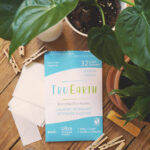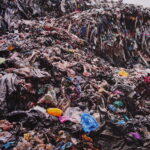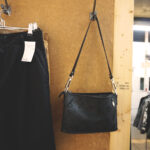Scarcity, desire and brand commitment
One of the primary criticisms regarding fashion is that reduction is rarely mentioned as part of a brand’s sustainability profile. All too often, we hear about recycled polyester, plastic-free packaging, carbon-offsetting shipping, and organic cotton.
And while all these things are fine, great even – they are not a sustainability make, not when we look at the numbers and the definition of sustainable textile. Reduction of products must be included in the business model for the sustainability policy to be serious. As such, you would think I would love luxury brands like Hermés, with their exclusivity perfectly exemplified by the Birkin or the Kelly bags that half the internet is gauging at.
With these bags, very few are made, creating extreme consumer demand and desire, but leaving many without a product. Ultimately, Hermès is walking the walk when it comes to reducing their production, and as a bonus, it seems to spike interest in consumers. However, that is not the whole truth. While very few Birkins and Kellys are made, a lot is left to be desired regarding sustainability.
While very few of these bags are made, consumers motivated to get one cannot just stroll into a store and sign up on a waitlist. Not everyone can buy a Birkin. Shoppers must prove their commitment to the brand – by continuously shopping there.
From what previous Hermès shoppers and managers say online, to even be considered for a bag, you must shop at the same Hermès store, use the same sales assistant, and “build a relationship” with the store. Some people rave online about having spent +$100.000 in a store to be considered. Mind you, these are all ramping-up purchases before the actual intended purchase.
To be considered for a Birkin, you have to keep buying. I am guessing that many of the purchases in the process are products that the consumers would not otherwise have bought, potentially not at least – if it had not been for the scarcity of the Birkin.

This is how one high fashion blog describes the dynamic in Hermès and how to “get in”:
“When you enter the store, you must find a Sales Associate willing and available to assist you. Ideally, a friend or relative will introduce you to someone with whom they have a relationship.
To cultivate a relationship with your SA, make sure you:[1]
- Dress well when visiting the boutique — preferably in Hermès clothing and shoes.
- Demonstrate knowledge of the entire Hermès line and the Birkin or Kelly specifically.
- Make multiple purchases at the same Hermès boutique, ideally with the same SA, to establish a purchasing history (aka your “profile”).
- While purchasing with each visit is not mandatory, establishing a purchasing history is critical to one day buying a Birkin or Kelly bag at a boutique.
- Purchase from a wide range of Hermès products so you do not appear interested only in getting a Birkin bag. Consider purchasing scarves, belts, jewellery, makeup, etc.”
Btw it is not up to you which bag you get; you get a choice based on your client file with Hermès, and if the bag is not your style and you turn it down, you might not be offered another.
This feels like a cult…. Or a really, really, really well-thought-out scam, where the scammer has convinced the scammee to be grateful for getting scammed. And while a few bags are made, the business model is still based on overconsumption, no matter how they frame it.
The History of the Birkin
Now let’s take a step back for a second because the becoming of the Birkin bag is quite an interesting story. The muse, or inspiration for it was British actress and singer Jane Birkin. She used to carry a huge wicker basket everywhere as her bag.
Apparently, in 1984, she sat beside the CEO of Hermes on a plane when all the contents of her wicker basket fell out as she tried to put it into the overhead compartment. The two started talking about bags and ended up designing the perfect bag for her, and that’s how the Birkin was born. If you look at any picture of Jane Birkin wearing the Birkin bag, you’ll see her actually using it.
Many Birkins today are not really used, it seems like. They are part of outfits and styling, but otherwise, they seem to be placed firmly on a shelf in a walk-in closet. The bag is elevated to this status because of its exclusivity and high price. But Jane’s is beaten down, stretched out, decorated with her trinkets, and just worn to shit. I think it is worth mentioning that Jane probably never paid for a Birkin in her life, and they were, generally speaking, a lot cheaper 20-30 years ago than they are today.
But overall, Jane seemed to have the idea of the bag down. She only owned one at a time, and she had a total of five Birkin bags in her life but she was never too precious about them not to use them.
Is Hermès a sustainable brand?
Today, Birkin prices start at just below $10.000 and can go into the millions. And with this price tag, Hermès should be a sustainable brand, right? Let us look at the facts and what your money will get you.
This is how Hermès describes their sustainability efforts: [2]
“Sustainability of natural resources. A responsible company, Hermès strives to limit its impact on the world while respecting nature, the source of its exceptional materials. In this regard, transparency, security and the local dimension of supply chains are the subject of particular consideration. “
Hermès picks some low-hanging fruit in terms of sustainability; they use organic cotton and have set goals regarding carbon reduction throughout their supply chain. Of course, Hermès produces long-lasting products that are supposed to last a lifetime, and simply using the same bag for decades will automatically lower its impact (however, that is also the case for other, cheaper options as well. This is also an impact based on consumer habits and not the actual production of the products – and we sought out to see what the brand is doing, and not how consumers use it).
Hermès and other luxury brands are not paying their workers fair wages. At the same time, a Birkin can quickly end up costing you $10.000; this does not guarantee that the people working in the supply chain were compensated fairly.
The Fashion Transparency Index awarded Hermès a 21-30% score, which indicates limited transparency. [3]Mostly in the late stages of the supply chain, where we tend to see higher wages. Hermès’ supply chain is also not certified by any critical labour standards.[4]
The brand’s use of leather, wool, down, fur, exotic animal skin, shearling, exotic animal hair, horn, and silk also significantly affects the impact – with no real action taken to ensure improved practices. There are no certifications for things like crocodile skin and exotic feathers, meaning the supply chain is rife with animal abuse and cruelty because, literally, no one is looking. This has made several designers move away from these materials, but that is still far from the norm, sadly. In terms of Hermès, the brand only traces some of its textiles and materials to the first production stage, so there is no transparency beyond that.
When everyone can join the club, is it really a club?
This is easily the most late-stage capitalism-esque notion I have seen in a while, and overall, it says something interesting about the cultural landscape of designer brands and fashion identity.
In many ways, what Hermès does is a genius contrast to fast fashion.
When you can get everything, anywhere, all the time, the blatant overconsumption removes exclusivity – many designers have launched collabs and more affordable collections with high street brands, which feels like leaving the private road open during rush hour. Because the more easily available something is, the quicker the prestige of it fades.
There is no need to explain that when you spend thousands of dollars on designer labels, you pay for the prestige those products bring. It has always been this way; designer fashion is a tool to distinguish yourself from the mainstream, the lower and middle classes, to signal something better, more successful, or excessive wealth.
However, fashion changes, and so does luxury fashion. While simply wearing items from a designer label and showing off the style and logo of that brand could previously set you aside from the masses, it is not like that anymore, necessarily. At least, not everywhere. Wearing flashy logos from designer labels is often considered tacky today, like you are trying too hard while void of personal taste and style. You do not join the club by wearing a Louis Vuitton logo bag and Chanel flats.
The quiet luxury is for those in the know. Its exclusivity doesn’t scream at you and ignore you, basically, because the quiet luxury is not seeking validation from those who do not recognise it. There are several examples of luxury brands not opting for flashy logo products but rather sticking to recognisable designs for those in the know. However, whether you are all for the logos or the quiet luxury, the overall premise is that you have consumer agency and can choose to purchase whatever style you want, right? (If you have thousands of dollars, mind you, but still).
Suppose you like setting yourself aside as a fashion aficionado. In that case, you remove the consumer agency and put all the power into the hands of the brand itself. When the brand can choose if you are worthy or not, we have created a level of exclusivity that would otherwise have been unattainable.
This is a familiar strategy, and it is not exclusive to the fashion world; we see the same with real estate, cars, wine trading, and many other industries. In many ways, although I find it deeply concerning that anyone would idolise a brand to the point of spending hundreds of thousands of dollars to feel like a better version of themselves or worthy of the recognition of certain groups, I also find it incredibly fascinating that a brand can do this.
You can spend your money on whatever you want; it is your money. However, what I find interesting is how a brand can reach this status of idolisation. You do not know the amount of tiktoks I have seen about Hermès deep dives and the fascination with these bags because the scarcer a product is, the more the collective fascination of it grows.
But it’s interesting to me that these bags have reached this level of exclusivity. The most expensive Birkin bag goes for roughly $2 million, which seems miles from how the original inspiration of the bag used to wear hers.
[1] https://madisonavenuecouture.com/blogs/news/how-to-buy-an-Hermès-bag-the-hard-way-and-the-easy-way
[2] https://www.Hermès.com/dk/en/content/134986-sustainable-development/
[3] https://www.fashionrevolution.org/about/transparency/
[4] https://goodonyou.eco/how-ethical-is-Hermès/




